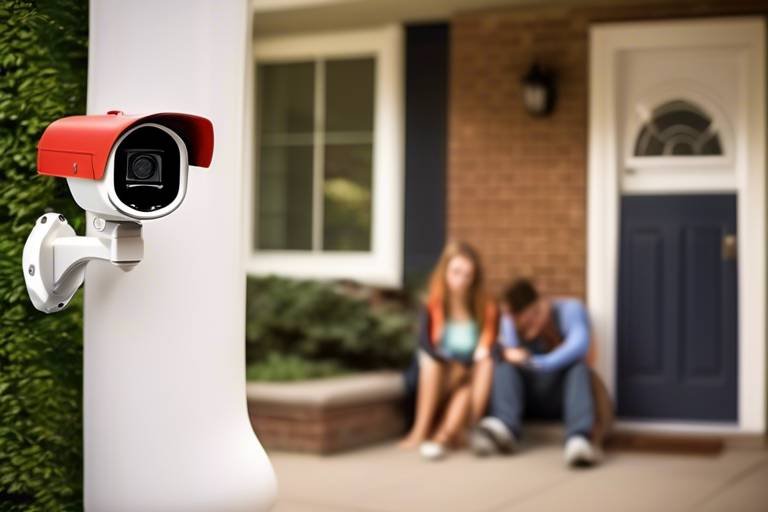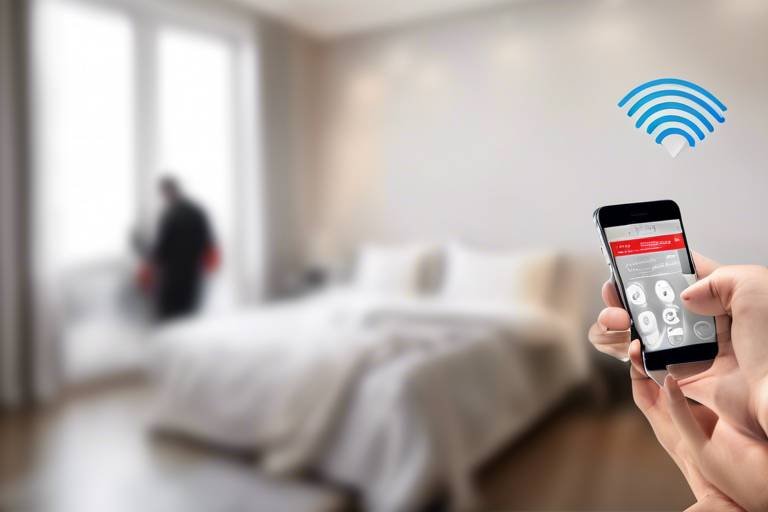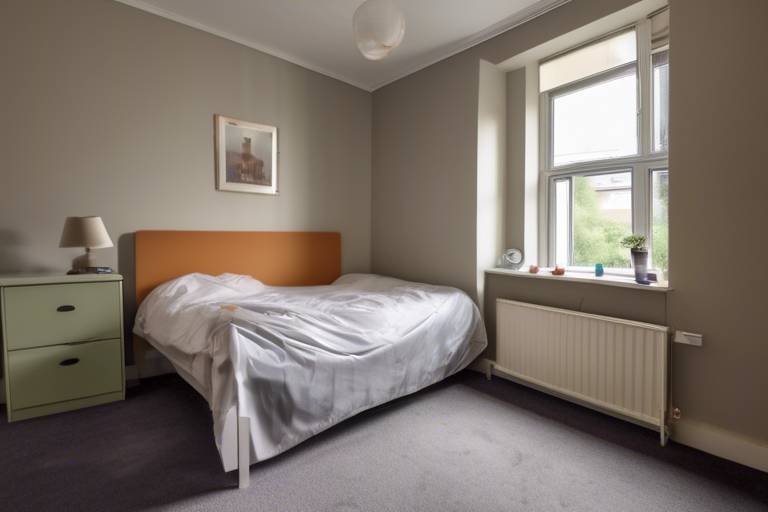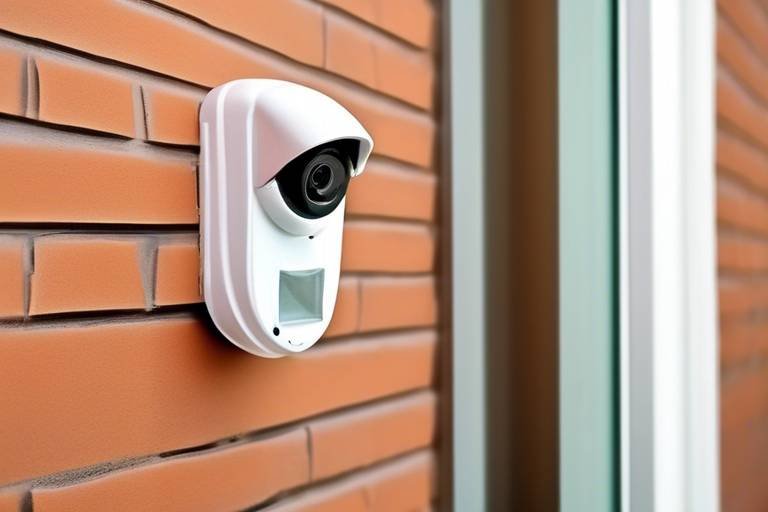Safety Tips for Working from Home
In today's world, where working from home has become the norm for many, it's essential to prioritize health and safety. While the flexibility of remote work offers numerous benefits, it also comes with its own set of challenges. From physical discomfort due to improper workspace setups to the risk of burnout from blurred work-life boundaries, it's crucial to adopt practices that enhance both productivity and well-being. This article will explore various safety tips that focus on physical, mental, and digital well-being, ensuring you can thrive in your home office environment.
Creating an ergonomic workspace is vital for preventing discomfort and injuries. Imagine trying to work on a couch all day – not only is it uncomfortable, but it can lead to long-term health issues like back pain or repetitive strain injuries. To avoid this, invest in proper furniture and equipment. Your chair should support your lower back, and your desk should be at a height that allows your elbows to rest at a 90-degree angle. Furthermore, consider the placement of your computer monitor; it should be at eye level to prevent neck strain. By setting up a workspace that supports your body, you can significantly enhance your productivity and comfort.
Establishing boundaries between work and personal life is crucial. When your home becomes your office, it’s easy to let work spill into your personal time. Have you ever found yourself answering emails late at night or working through your lunch break? To combat this, set clear work hours and stick to them. Communicate these boundaries to your colleagues and family, so they understand when you are available. Additionally, create a designated workspace that you can "leave" at the end of the day. This physical separation can help signal to your brain that it’s time to switch off from work mode and enjoy personal time.
With increased remote work, digital security is paramount. Protecting sensitive information should be a top priority for anyone working from home. Use strong, unique passwords for all your accounts and consider enabling two-factor authentication for an extra layer of security. Be wary of phishing attempts; always verify the source of unexpected emails or messages before clicking on links. Regularly updating your software and antivirus programs can also help safeguard your devices against potential threats. Remember, a secure digital environment is fundamental to maintaining your productivity and peace of mind.
Incorporating physical activity into your daily routine is essential for health. Working from home can lead to a sedentary lifestyle, which is often linked to various health issues. To combat this, aim to take short breaks every hour. Stand up, stretch, or even take a quick walk around your home. You could also set up a standing desk or try working from different locations within your home. Consider scheduling regular workouts, whether it's a brisk walk, yoga, or a home workout session. Staying active not only boosts your physical health but can also improve your mood and focus.
Mental health can be challenged while working remotely. The isolation and lack of social interaction can lead to feelings of loneliness or anxiety. To promote a positive mindset, make it a point to connect with colleagues regularly, whether through video calls or instant messaging. Establishing a routine that includes time for relaxation and hobbies can also help maintain emotional well-being. Don’t hesitate to seek professional help if you find yourself struggling; mental health is just as important as physical health.
Clear communication is key in a remote work environment. Without face-to-face interactions, it’s easy for messages to be misinterpreted. Utilize tools like video conferencing, instant messaging, and project management software to enhance collaboration. Setting up regular check-ins with your team can foster a sense of connection and ensure everyone is on the same page. Remember to be clear and concise in your messages, and don’t shy away from asking for clarification when needed. Effective communication can bridge the gap created by distance and enhance teamwork.
Effective time management is crucial for productivity. When working from home, distractions abound, from laundry to social media. To tackle this, prioritize your tasks each day. Consider using techniques like the Pomodoro Technique, where you work for 25 minutes and then take a 5-minute break. This method can help maintain focus while preventing burnout. Additionally, using a digital calendar can keep you organized and remind you of deadlines. By managing your time wisely, you can accomplish more and feel less overwhelmed.
Minimizing distractions is vital for focus. A cluttered space can lead to a cluttered mind, making it difficult to concentrate. Take the time to organize your workspace, removing unnecessary items that could divert your attention. If possible, choose a quiet area of your home for work, away from noise and interruptions. Consider using noise-canceling headphones or background music to help drown out distractions. Creating a conducive work environment can significantly enhance your productivity and focus.
Establishing a daily routine can enhance productivity and structure. Just like a traditional work environment, having a set schedule at home can help you stay on track. Start your day at the same time, and include regular breaks to recharge. Incorporate activities that signal the beginning and end of your workday, such as a morning coffee ritual or an evening walk. A consistent routine not only boosts productivity but also creates a sense of normalcy in an otherwise unpredictable world.
Q: How can I stay motivated while working from home?
A: Set clear goals for each day, create a structured routine, and take regular breaks to maintain motivation.
Q: What are some effective ways to communicate with my team remotely?
A: Utilize video calls, instant messaging, and collaborative tools to enhance communication and connection.
Q: How can I separate work and personal life when working from home?
A: Establish clear work hours, create a designated workspace, and communicate your boundaries to others.

Ergonomic Workspace Setup
Creating an ergonomic workspace is not just a trend; it’s a necessity for anyone working from home. Imagine sitting in a chair that feels like a cloud versus one that feels like a rock. Which one do you think would help you focus better and keep your back from screaming at you by the end of the day? When you set up your workspace, consider how it impacts your physical health and productivity. An ergonomic setup aims to support your body’s natural posture, minimizing strain and discomfort.
First things first, let’s talk about your chair. A good ergonomic chair should have adjustable height, lumbar support, and armrests. This will help you maintain a comfortable position that supports your lower back. If your chair lacks proper support, you might find yourself slumping over your desk, which can lead to chronic pain. Pair your chair with a desk that allows for a comfortable arm position while typing. Your elbows should be at a 90-degree angle, which means your desk height is crucial.
Next, let’s not forget about your monitor. Position your screen at eye level, about an arm's length away. This setup prevents neck strain and encourages better posture. If you’re using a laptop, consider investing in a laptop stand or an external monitor. You can also use an external keyboard and mouse to create a more comfortable arrangement. This way, you can keep your wrists straight and reduce the risk of repetitive strain injuries.
Lighting is another key element of an ergonomic workspace. Natural light is ideal, but if that’s not possible, ensure your workspace is well-lit to avoid eye strain. Use desk lamps with adjustable brightness to create a comfortable environment. Remember, your workspace should feel inviting, not like a dungeon!
Here’s a quick breakdown of essential ergonomic components:
| Component | Recommended Features |
|---|---|
| Chair | Adjustable height, lumbar support, armrests |
| Desk | Height-adjustable, spacious |
| Monitor | Eye level, at least 20 inches away |
| Keyboard & Mouse | Wrist support, comfortable positioning |
| Lighting | Natural light or adjustable desk lamp |
Don’t underestimate the power of your workspace. It’s where you spend a large portion of your day, so it should be comfortable and functional. By investing time and resources into creating an ergonomic workspace, you’re not just enhancing your comfort; you’re boosting your productivity and overall well-being. Remember, a happy worker is a productive worker!

Maintaining a Work-Life Balance
In today's fast-paced world, where the boundaries between work and personal life often blur, maintaining a healthy work-life balance has become more crucial than ever. When you work from home, it’s all too easy to find yourself glued to your laptop long after your official hours have ended. This can lead to burnout, stress, and a decline in both productivity and happiness. So, how can you effectively separate your work from your personal life while still reaping the benefits of remote work?
First and foremost, setting clear boundaries is essential. Designate specific work hours and communicate these to your colleagues and family. Let them know when you are available and when you are not. This simple act can work wonders in helping you to mentally switch off from work mode at the end of the day. Consider creating a visual cue to mark the start and end of your workday. For example, you might close your office door or put on a different outfit to signal the transition from work to personal time.
Another effective strategy is to create a dedicated workspace. This doesn’t necessarily mean you need a separate room; a corner of your living room or a specific desk can work just fine. The key is to have a physical space that is designated for work. When you step away from this space, both your mind and body will begin to recognize that it’s time to relax and unwind. It’s like having a mental switch that you can turn on and off, making it easier to disconnect from work.
Moreover, incorporating regular breaks into your day can significantly enhance your work-life balance. Consider using the Pomodoro Technique, which involves working for 25 minutes and then taking a 5-minute break. This not only boosts productivity but also allows you to step away from your screen, stretch, and recharge. During these breaks, engage in activities that bring you joy, whether it’s a quick walk, a few minutes of meditation, or simply enjoying a cup of tea. These moments of respite can rejuvenate your mind and body, making it easier to return to work with renewed energy.
Lastly, don’t underestimate the power of saying “no.” Whether it’s an extra project at work or social commitments that drain your energy, being selective about how you spend your time can lead to a healthier balance. Prioritize your mental and emotional well-being by recognizing your limits and respecting them. Just like a well-tended garden, your personal life needs attention and care to thrive. When you cultivate a balance between work and leisure, you create a more fulfilling and productive life.
In summary, maintaining a work-life balance while working from home is not just about time management; it’s about creating a lifestyle that prioritizes your well-being. By setting boundaries, creating a dedicated workspace, incorporating breaks, and learning to say no, you can foster an environment that allows both your professional and personal life to flourish. Remember, a balanced life is a happy life!
Q: How can I effectively set boundaries while working from home?
A: Clearly communicate your work hours to colleagues and family, and create a physical workspace that you can step away from at the end of the day.
Q: What are some quick activities I can do during breaks?
A: Consider stretching, taking a short walk, practicing mindfulness, or enjoying a healthy snack to recharge during your breaks.
Q: How do I know when to say no to extra work?
A: Assess your current workload and emotional state. If taking on more work will compromise your well-being or productivity, it’s okay to decline.

Digital Security Measures
In today’s digital age, where the lines between our personal and professional lives blur, digital security has become more crucial than ever, especially for those working from home. Imagine your home office as a fortress; it needs strong walls and a secure gate to keep unwanted intruders out. Just like you wouldn’t leave your front door wide open, you shouldn’t leave your digital information vulnerable. So, what can you do to enhance your digital security while working from the comfort of your home?
First and foremost, it’s essential to use strong passwords. A weak password is like a flimsy lock on your door. Make sure your passwords are at least 12 characters long and include a mix of letters, numbers, and symbols. Consider using a password manager to help you generate and store complex passwords securely. This tool acts as your personal security guard, making sure you never have to remember every single password.
Next, enable two-factor authentication (2FA) on all your accounts whenever possible. This is similar to having a second lock on your door. Even if someone gets hold of your password, they won’t be able to access your account without that second piece of information. Whether it’s a text message code or an authentication app, 2FA adds an extra layer of security that is hard to bypass.
Keeping your software and devices up to date is another critical measure. Software updates often contain security patches that fix vulnerabilities. Think of it as a routine maintenance check for your car; it helps keep everything running smoothly and securely. Set your devices to update automatically, or make it a habit to check for updates regularly.
Furthermore, be cautious about the information you share online. Social media can be a double-edged sword. While it’s great for connecting with friends and colleagues, oversharing can leave you vulnerable to cyberattacks. Always think twice before posting personal details that could be exploited. Remember, your digital footprint is like a breadcrumb trail; make sure it doesn’t lead intruders right to your door.
Finally, consider using a virtual private network (VPN) when accessing public Wi-Fi. Public networks are notoriously insecure, making it easy for hackers to intercept your data. A VPN encrypts your internet connection, creating a secure tunnel that protects your information from prying eyes. It’s like wearing a disguise while you’re out in public; it helps keep your identity safe.
In summary, enhancing your digital security while working from home is not just about having the right tools but also about adopting the right mindset. By implementing these measures, you can create a secure digital environment that allows you to focus on your work without constantly worrying about potential threats. Remember, the internet is a vast space, and while it offers countless opportunities, it also harbors risks. Stay vigilant and proactive in safeguarding your digital life.
- What is two-factor authentication?
Two-factor authentication (2FA) is a security process that requires two different forms of identification to access an account, enhancing security beyond just a password. - How often should I update my passwords?
It’s advisable to update your passwords every 3 to 6 months or immediately if you suspect any security breach. - What is a VPN and why do I need one?
A VPN (Virtual Private Network) encrypts your internet connection, providing privacy and security when using public Wi-Fi networks.

Staying Physically Active
In the hustle and bustle of working from home, it's all too easy to slip into a sedentary lifestyle. You know how it goes: you wake up, grab your coffee, and settle down in front of your computer, only to realize hours later that you haven’t moved a muscle! This is where becomes not just a luxury, but a necessity. Incorporating movement into your daily routine can significantly boost your energy levels, improve your mood, and enhance your overall productivity. But how do you make it happen when your couch is just a few steps away?
First off, let’s talk about the power of small changes. You don't need a gym membership or fancy equipment to stay active. Simple adjustments can lead to significant improvements. For instance, consider setting a timer to remind yourself to take short breaks every hour. During these breaks, you can do a quick set of stretches or even a few jumping jacks. It’s like giving your body a mini recharge! You might be surprised at how just a few minutes of movement can invigorate you and sharpen your focus.
Another effective strategy is to incorporate physical activity into your daily tasks. For example, if you have a conference call, why not stand up or pace around your room while you talk? This not only keeps your blood flowing but also helps you think more clearly. If you’re feeling adventurous, try a quick dance session to your favorite song during lunch breaks. It's fun, energizing, and a great way to shake off any stress that’s built up during the morning.
Moreover, consider turning your home into a mini gym. You don’t need much space or equipment; a yoga mat and a couple of dumbbells can go a long way. You could even use household items as weights! Fill a couple of water bottles and use them for strength training. The key here is to find activities you enjoy, whether it's yoga, pilates, or a quick cardio workout. Enjoyment is the secret ingredient that keeps you coming back for more!
For those who thrive on structure, creating a dedicated workout schedule can be incredibly beneficial. Just like you schedule meetings and deadlines, schedule your workouts too. Treat them as non-negotiable appointments. You might want to start your day with a brisk walk or wrap up your work with a calming yoga session. Having a routine not only helps in building a habit but also ensures that you prioritize your physical health amidst your work commitments.
Lastly, don’t underestimate the power of community. Engaging with friends or colleagues in physical activities can make a world of difference. Consider setting up virtual workout sessions or challenges. Whether it's a step count competition or a group yoga class over Zoom, sharing your fitness journey with others can motivate you to stay active and accountable.
In conclusion, staying physically active while working from home is all about making conscious choices and finding what works for you. Remember, it’s not about perfection; it’s about progress. Every little bit counts, and the more you can integrate movement into your day, the better you’ll feel both physically and mentally. So, get moving and watch your productivity soar!
- How often should I take breaks to stay active? It’s recommended to take a break every hour, even if it’s just for a few minutes to stretch or walk around.
- What are some quick exercises I can do at home? Simple exercises like jumping jacks, push-ups, or even yoga stretches can be done in just a few minutes.
- Can I stay active without a gym membership? Absolutely! There are plenty of activities you can do at home with little to no equipment.
- How can I motivate myself to exercise while working from home? Setting a routine, finding enjoyable activities, and involving friends can all help keep you motivated.

Managing Mental Health
Working from home can be a double-edged sword. On one hand, you get to ditch the commute and work in your pajamas, but on the other, it can lead to feelings of isolation and stress. It's essential to prioritize your mental health while navigating the challenges of remote work. Just like a plant needs sunlight and water to thrive, your mind needs the right care and attention to flourish in a home office setting.
One of the first steps to managing your mental health is to recognize the signs of stress and anxiety. Are you feeling overwhelmed by deadlines? Or maybe you're struggling to concentrate? Acknowledging these feelings is crucial. It’s like having a check engine light in your car; ignoring it can lead to bigger problems down the road. When you notice these signs, take a moment to breathe and assess your situation.
Incorporating regular breaks into your daily routine can significantly boost your mental well-being. Just like you wouldn’t run a marathon without hydration, you shouldn’t work for long stretches without stepping away. Consider implementing the Pomodoro Technique, where you work for 25 minutes and then take a 5-minute break. This method can help refresh your mind and improve focus. You might be surprised at how much more productive you can be when you give your brain a little breather!
Another effective strategy is to establish a support system. Just as a team in a sports game relies on each other, you should lean on your colleagues, friends, or family for emotional support. Schedule regular check-ins with coworkers or friends to share your experiences and feelings. This can foster a sense of community and remind you that you’re not alone in this journey. You might even consider setting up a virtual coffee break, where you can chat about non-work-related topics.
Additionally, don’t underestimate the power of physical activity. Exercise releases endorphins, those magical little chemicals that boost your mood. Even a short walk around your home or a quick workout can help clear your mind and reduce feelings of anxiety. Create a daily routine that includes some form of physical activity, whether it’s yoga, dancing, or just stretching. Think of it as a mental reset button that can help you tackle your tasks with a fresh perspective.
Lastly, practicing mindfulness can be a game-changer. Techniques such as meditation, deep breathing, or journaling can help you stay grounded and focused. Consider setting aside a few minutes each day for mindfulness practices. It’s like giving your brain a mini-vacation, allowing it to recharge and come back stronger. Apps like Headspace or Calm can guide you through meditation sessions, making it easier to incorporate this practice into your routine.
In summary, managing your mental health while working from home requires a proactive approach. By recognizing stress signals, incorporating breaks, building a support network, staying active, and practicing mindfulness, you can create a healthier work environment that nurtures both your productivity and well-being. Remember, just as you would care for a beloved pet or plant, your mind deserves the same attention and care.
- How can I identify if my mental health is suffering while working from home?
Look for signs such as increased anxiety, difficulty concentrating, or feelings of isolation. Regular self-reflection can help you recognize these changes. - What are some quick ways to relieve stress during the workday?
Taking short breaks, practicing deep breathing, or stepping outside for fresh air can provide immediate relief. - How important is physical activity for mental health?
Physical activity is crucial as it releases endorphins that improve mood and reduce stress levels. - Can mindfulness really make a difference?
Yes! Mindfulness practices can help you stay present, reduce anxiety, and improve overall mental clarity.

Effective Communication Techniques
In a world where remote work has become the norm, effective communication is no longer just a nice-to-have; it's a necessity. Picture this: you're sitting at your home office, and your colleague sends you a message that leaves you scratching your head. Without the right communication techniques, misunderstandings can spiral out of control, leading to frustration and decreased productivity. So, how do we bridge that gap and ensure our messages hit the mark?
First off, clarity is king. When you're typing out an email or a message, take a moment to think about what you want to convey. Are you being clear? Are your points easy to understand? Using simple language, avoiding jargon, and being specific can make a world of difference. For instance, instead of saying, "Let's touch base later," try, "Can we schedule a meeting for Thursday at 2 PM to discuss the project?" This way, you're not leaving anything to chance.
Another vital technique is to leverage the right tools. In today's digital age, we have a smorgasbord of communication platforms at our disposal. From Slack to Zoom and everything in between, each tool serves a unique purpose. For quick updates, a chat app might be ideal, while video calls are perfect for more in-depth discussions. But remember, the tool should fit the message you're trying to communicate. Using a video call for a simple status update might feel like using a sledgehammer to crack a nut!
Moreover, active listening plays a crucial role in effective communication. When someone is speaking, whether in a meeting or a one-on-one chat, make a conscious effort to listen. This means not just hearing their words but understanding their message. You can show you're engaged by nodding, asking follow-up questions, or summarizing what they've said. This not only shows respect but also reduces the chances of miscommunication.
Additionally, don't underestimate the power of body language in virtual meetings. Although you might be behind a screen, your non-verbal cues still matter. Make eye contact, smile, and use hand gestures to emphasize your points. These small gestures can create a more engaging and friendly atmosphere, making it easier for everyone to communicate openly.
Lastly, be open to feedback. Communication is a two-way street, and inviting feedback can help you refine your communication style. Ask your colleagues if they feel understood and if there’s anything you could improve. This not only enhances your skills but also fosters a culture of open dialogue within your team.
In summary, mastering effective communication techniques while working from home can significantly enhance collaboration and team spirit. By being clear, choosing the right tools, actively listening, minding your body language, and welcoming feedback, you can create a more connected and productive remote work environment. So, the next time you log in for a virtual meeting, remember: communication is not just about talking; it’s about connecting!
- What are the best tools for remote communication?
Some popular tools include Slack for messaging, Zoom for video calls, and Trello for project management.
- How can I improve my active listening skills?
Practice summarizing what others say and ask questions to clarify their points.
- Why is body language important in virtual meetings?
Body language helps convey emotions and engagement, making communication more effective.

Time Management Strategies
Time management is like the secret sauce to productivity, especially when you're working from home. Imagine trying to bake a cake without measuring the ingredients—chaos, right? That's how your workday can feel without a solid time management strategy. The key is to find a balance that allows you to get your work done efficiently while still leaving room for personal time. So, how do you do it? Let’s dive into some effective strategies that can transform your work-from-home experience.
First off, you need to **set clear goals**. Think of them as your roadmap. Without a destination, you might just end up driving in circles. Start by defining what you want to achieve each day. You can use the SMART criteria—Specific, Measurable, Achievable, Relevant, and Time-bound—to ensure your goals are well-structured. For instance, instead of saying, “I want to work on my project,” you could say, “I will complete the first draft of my project report by 3 PM today.” This clarity not only keeps you focused but also gives you a sense of accomplishment when you tick off those boxes.
Next, consider using a **time-blocking technique**. This is where you allocate specific chunks of time to different tasks. Picture your day as a puzzle, where each piece represents a task that fits into your schedule. By dedicating blocks of time to specific activities, you minimize distractions and create a sense of urgency. For example, you might block out 9 AM to 11 AM for deep work, followed by a break, and then tackle emails from 11:30 AM to 12 PM. This method not only boosts productivity but also helps you stay organized.
Another essential strategy is to **prioritize tasks** effectively. Not all tasks are created equal, and understanding which tasks are urgent versus important can make a world of difference. You can use the Eisenhower Matrix, a simple tool that helps you categorize tasks into four quadrants:
| Urgent | Not Urgent | |
|---|---|---|
| Important | 1. Do First | 3. Schedule |
| Not Important | 2. Delegate | 4. Eliminate |
This matrix allows you to focus on what truly matters, ensuring that you’re not just busy but actually productive. By tackling high-priority tasks first, you set a positive tone for the rest of your day.
Additionally, don’t underestimate the power of **taking breaks**. It might sound counterintuitive, but stepping away from your desk can actually enhance your productivity. Think of your brain as a computer; if you keep it running without a break, it might just freeze up. Short, regular breaks can refresh your mind and help you return to your tasks with renewed energy. Try the Pomodoro Technique, where you work for 25 minutes and then take a 5-minute break. This cycle can help maintain your focus and prevent burnout.
Finally, using digital tools can significantly enhance your time management skills. Applications like Trello, Asana, or even Google Calendar can help you keep track of your tasks and deadlines. These tools act as your personal assistant, reminding you of what needs to be done and when. Plus, they allow for easy collaboration if you’re working with a team, keeping everyone on the same page.
In conclusion, mastering time management while working from home is all about finding the right strategies that work for you. By setting clear goals, using time-blocking, prioritizing effectively, taking breaks, and leveraging technology, you can create a productive work environment that not only enhances your efficiency but also ensures you enjoy your personal time. After all, life is too short to spend it all working, right?
- What is the best time management technique for remote workers? The best technique varies by individual, but time-blocking and the Pomodoro Technique are popular choices.
- How can I stay motivated while working from home? Setting clear goals and creating a structured routine can help maintain motivation.
- Are there any tools that can help with time management? Yes, tools like Trello, Asana, and Google Calendar are excellent for managing tasks and staying organized.
- How often should I take breaks during work? It's recommended to take a 5-minute break every 25 minutes to maintain focus and prevent burnout.

Creating a Distraction-Free Environment
In our fast-paced world, distractions are everywhere, especially when working from home. Whether it's the alluring glow of your smartphone, the tempting sounds of the TV, or even the household chores calling your name, these distractions can significantly hinder your productivity. So, how do you create a workspace that allows you to focus and get things done? The answer lies in crafting a distraction-free environment tailored to your needs.
First things first, let’s talk about your workspace. Ideally, you should have a dedicated area that’s exclusively for work. This doesn’t mean you need a home office; it could be a corner of your living room or even a cozy nook in your bedroom. The key is to segregate your work area from your personal space. By doing this, your brain can better associate that area with productivity, making it easier to get into the right mindset.
Next, consider the physical setup of your workspace. Keep it tidy and organized. Clutter can be a significant distraction. Take a moment to remove any unnecessary items from your desk. A clean workspace can help clear your mind, allowing you to focus better on the tasks at hand. You might also want to personalize your space with a few motivational quotes or images that inspire you, but be careful not to overdo it. Too many visuals can become distracting rather than uplifting.
Now, let’s address the noise factor. If you live in a bustling environment, consider investing in a good pair of noise-canceling headphones. They can be a game-changer! Alternatively, you could play some soft background music or white noise to drown out distractions. Just make sure it’s not too loud or engaging, as that can pull your focus away from your work.
Another crucial aspect of creating a distraction-free environment is managing your digital devices. We all know how easy it is to get sucked into social media or endless scrolling. To combat this, try using apps that block distracting websites during work hours. You can also set your phone to “Do Not Disturb” mode to minimize interruptions. By taking these steps, you can significantly reduce the chances of being sidetracked by the digital world.
Additionally, it’s essential to communicate your work hours to those you live with. Let them know when you’re working and ask for their support in minimizing interruptions. This can be as simple as putting up a “Do Not Disturb” sign or having a quick chat about your schedule. When everyone is on the same page, it creates a more conducive environment for focus.
Lastly, remember to take breaks. It might sound counterintuitive, but stepping away from your workspace can actually enhance your concentration. During these breaks, engage in activities that refresh your mind, such as stretching, going for a short walk, or grabbing a snack. This not only helps you recharge but also keeps your mind sharp for when you return to work.
In summary, creating a distraction-free environment while working from home is all about setting boundaries, organizing your space, managing noise, and minimizing digital distractions. By implementing these strategies, you’ll find it easier to focus, be more productive, and ultimately enjoy your work-from-home experience.
- What should I do if I can't find a quiet space in my home?
Consider using noise-canceling headphones or playing soft background music to help drown out distractions. - How can I prevent digital distractions while working?
Use website-blocking apps and set your phone to “Do Not Disturb” during work hours. - Is it important to have a dedicated workspace?
Yes, having a dedicated workspace helps you mentally separate work from personal life, enhancing focus and productivity.

Setting Up a Routine
Establishing a daily routine while working from home can be a game changer for your productivity and mental well-being. Think of it as your personal roadmap; without it, you might find yourself wandering aimlessly through your day, unsure of what to tackle next. A well-structured routine not only helps you stay organized but also creates a sense of normalcy in an otherwise chaotic environment. So, how do you go about creating a routine that works for you?
First and foremost, start by identifying your peak productivity hours. Are you a morning person who thrives with the sunrise, or do you hit your stride in the afternoon? Recognizing when you work best allows you to allocate your most challenging tasks during those times. For instance, if you find that you’re most alert in the morning, reserve that time for deep work, such as brainstorming or project planning. Conversely, save lighter tasks, like responding to emails, for when you feel your energy dip.
Next, consider incorporating breaks into your routine. It might sound counterintuitive, but taking regular breaks can actually enhance your focus and creativity. You could adopt the Pomodoro Technique, which involves working for 25 minutes and then taking a 5-minute break. After completing four cycles, treat yourself to a longer break of 15-30 minutes. This method not only keeps your mind fresh but also provides a structured way to manage your time. Here’s a simple breakdown:
| Activity | Duration |
|---|---|
| Work Session | 25 minutes |
| Short Break | 5 minutes |
| Long Break | 15-30 minutes (after 4 sessions) |
Additionally, setting a start and end time for your workday can help you maintain boundaries and avoid the pitfall of overworking. It’s easy to lose track of time when your office is just a few steps away from your living room. By establishing a clear schedule, you signal to your brain when it’s time to focus and when it’s okay to unwind. To make your routine even more effective, consider adding a morning ritual that sets a positive tone for the day. This could include activities like meditation, a quick workout, or reading a few pages of a book. The key is to create a transition from your personal life into your work life.
Lastly, don’t forget to be flexible. Life happens, and sometimes you may need to adjust your routine to accommodate unexpected events. The beauty of working from home is that you have the freedom to adapt your schedule as needed. Embrace the changes, and don’t be too hard on yourself if things don’t go exactly as planned. Remember, a routine is a tool to enhance your productivity, not a rigid rulebook. By setting a routine that works for you, you can create a more balanced and fulfilling work-from-home experience.
- How long should my routine be? Your routine can vary in length, but aim for a structure that covers your entire workday while allowing for breaks and personal time.
- What if I get bored with my routine? It’s perfectly normal to feel that way! Feel free to mix things up by trying new activities or changing the order of your tasks.
- Can I stick to a routine if I have kids at home? Yes! Communicate with your family about your work hours and involve them in creating a schedule that works for everyone.
Frequently Asked Questions
- What is an ergonomic workspace setup?
An ergonomic workspace setup involves arranging your work environment to support your body and reduce strain. This includes using a chair that supports your back, a desk at the right height, and positioning your computer screen at eye level. Essentially, it's about creating a space where you can work comfortably for long periods without discomfort.
- How can I maintain a healthy work-life balance while working from home?
Maintaining a healthy work-life balance is all about setting boundaries. You can achieve this by establishing a dedicated workspace, sticking to a schedule, and making time for breaks and personal activities. It's like drawing a line in the sand—once you cross it, you're in your personal time zone!
- What digital security measures should I take when working remotely?
To protect your sensitive information while working from home, consider using strong, unique passwords, enabling two-factor authentication, and regularly updating your software. Think of it as locking your front door: you wouldn’t leave it wide open, right?
- How can I stay physically active while working from home?
Staying active at home can be as simple as taking short breaks to stretch, going for a walk during lunch, or even incorporating quick workouts into your day. It’s all about finding little ways to move—like sneaking in a dance party between meetings!
- What strategies can I use to manage my mental health while working remotely?
Managing mental health while working from home involves practicing self-care, staying connected with friends and family, and setting aside time for relaxation. It’s important to check in with yourself, just like you would with a friend who seems a bit off.
- How can I improve communication with my colleagues when working from home?
Improving communication in a remote environment can be achieved by using tools like video calls, instant messaging, and regular check-ins. Think of it like being a conductor of an orchestra—everyone needs to be in sync to create beautiful music together!
- What time management strategies work best for remote work?
Effective time management can include techniques like the Pomodoro Technique, prioritizing tasks, and setting specific goals for the day. It’s like having a roadmap for your journey—without it, you might just end up wandering around!
- How can I create a distraction-free work environment at home?
To create a distraction-free environment, consider minimizing noise, organizing your workspace, and setting boundaries with those around you. It’s about crafting your own little bubble of focus, where distractions are kept at bay!
- Why is establishing a routine important when working from home?
Establishing a routine helps create structure and predictability, which can enhance productivity and reduce stress. Think of it like having a daily playlist—each song flows into the next, creating a harmonious workday!



















